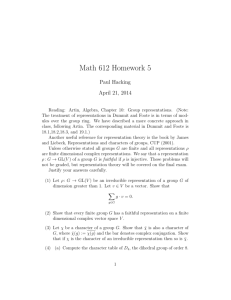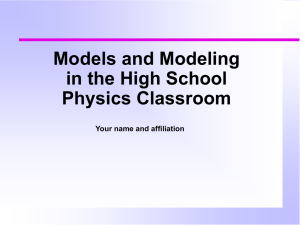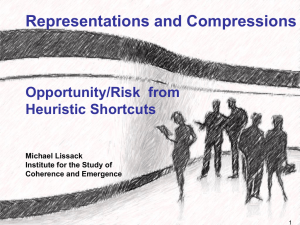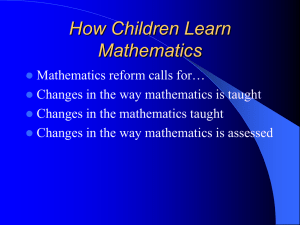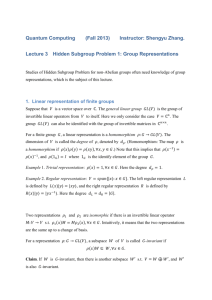CONTENTS
advertisement
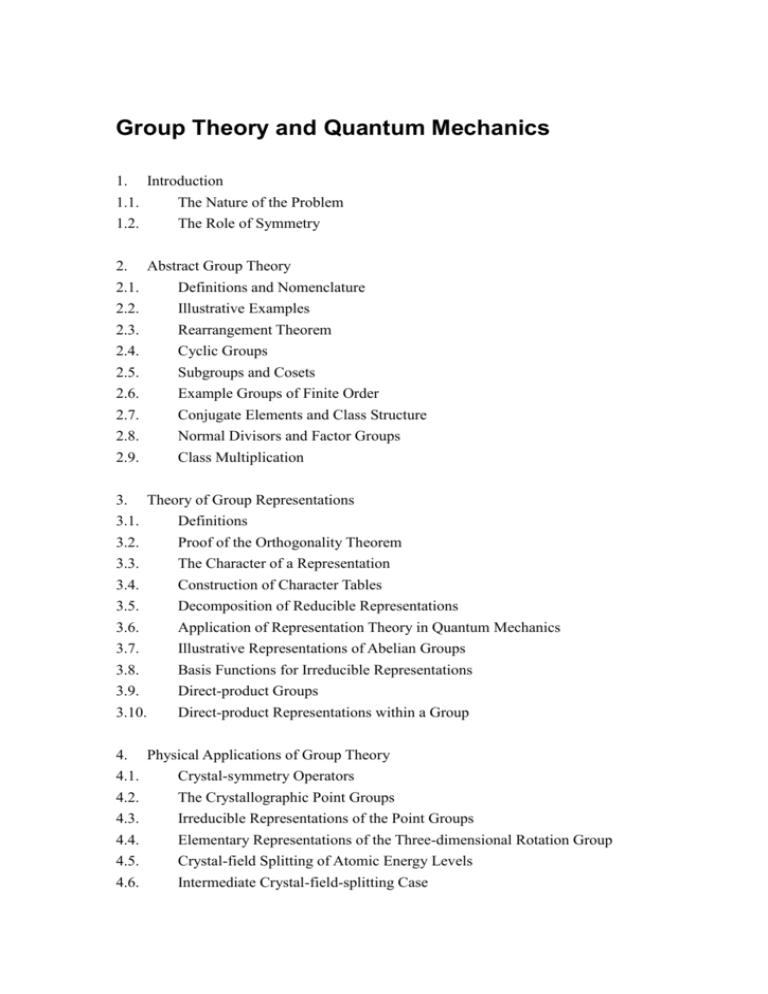
Group Theory and Quantum Mechanics 1. Introduction 1.1. The Nature of the Problem 1.2. The Role of Symmetry 2. Abstract Group Theory 2.1. Definitions and Nomenclature 2.2. Illustrative Examples 2.3. 2.4. 2.5. Rearrangement Theorem Cyclic Groups Subgroups and Cosets 2.6. 2.7. 2.8. 2.9. Example Groups of Finite Order Conjugate Elements and Class Structure Normal Divisors and Factor Groups Class Multiplication 3. Theory of Group Representations 3.1. Definitions 3.2. 3.3. 3.4. 3.5. 3.6. 3.7. 3.8. 3.9. 3.10. Proof of the Orthogonality Theorem The Character of a Representation Construction of Character Tables Decomposition of Reducible Representations Application of Representation Theory in Quantum Mechanics Illustrative Representations of Abelian Groups Basis Functions for Irreducible Representations Direct-product Groups Direct-product Representations within a Group 4. Physical Applications of Group Theory 4.1. Crystal-symmetry Operators 4.2. The Crystallographic Point Groups 4.3. Irreducible Representations of the Point Groups 4.4. Elementary Representations of the Three-dimensional Rotation Group 4.5. Crystal-field Splitting of Atomic Energy Levels 4.6. Intermediate Crystal-field-splitting Case 4-7. Weak-crystal-field Case and Crystal Double Groups 4.8. 4.9. 4.10. 4.11. 4.12. Introduction of Spin Effects in the Medium-field Case Group-theoretical Matrix-element Theorems Selection Kules and Parity Directed Valence Application of Group Theory to Directed Valence 5. Full Rotation Group and Angular Momentum 5.1. Rotational Transformation Properties and Angular Momentum 5.2. Continuous Groups 5.3. Representation of Rotations through Eulerian Angles 5.4. 5.5. 5.6. Homomorphism with the Unitary Group Representations of the Unitary Group Representation of the Rotation Group by Representations of the Unitary Group 5.7. 5.8. 5.9. 5.10. 5.11. 5.12. Application of the Rotation-representation Matrices Vector Model for Addition of Angular Momenta The Wigner or Clebsch-Gordan Coefficients Notation, Tabulations, and Symmetry Properties of the Wigner Coefficients Tensor Operators The Wigner-Eckart Theorem 5.13. 5.14. 5.15. 5.16. 5.17. The Racah Coefficients Application of Racah Coefficients The Rotation-Inversion Group Time-reversal Symmetry More General Invariances 6. Quantum Mechanics of Atoms 6.1. Review of Elementary Atomic Structure and Nomenclature 6.2. The Hamiltonian 6.3. 6.4. 6.5. 6.6. 6.7. 6.8. 6.9. 6.10. Approximate Eigenfunctions Calculation of Matrix Elements between Determinantal Wavefunctions Hartree-Fock Method Calculation of L-S-term Energies Evaluation of Matrix Elements of the Energy Eigenfunctions and Angular-momentum Operations Calculation of Fine Structure Zeeman Effect 6.11. Magnetic Hyperfine Structure 6.12. Electric Hyperfine Structure 7. Molecular Quantum Mechanics 7.1. Born-Oppenheimer Approximation 7.2. Simple Electronic Eigenfunctions 7.3. Irreducible Representations for Linear Molecules 7.4. The Hydrogen Molecule 7.5. Molecular Orbitals 7.6. Heitler-London Method 7.7. Orthogonal Atomic Orbitals 7.8. 7.9. 7.10. Group Theory and Molecular Orbitals Selection Rules for Electronic Transitions Vibration of Diatomic Molecules 7.11. 7.12. 7.13. 7.14. 7.15. 7.16. 7.17. Normal Modes in Polyatomic Molecules Group Theory and Normal Modes Selection Rules for Vibrational Transitions Molecular Rotation Effect of Nuclear Statistics on Molecular Rotation Asymmetric Rotor Vibration-Rotation Interaction 7.18. Rotation-Electronic Coupling 8. Solid-state Theory 8.1. Symmetry Properties in Solids 8.2. The Reciprocal Lattice and Brillouin Zones 8.3. Form of Energy-band Wavefunctions 8.4. Crystal Symmetry and the Group of the k Vector 8.5. Pictorial Consideration of Eigenfunctions 8.6. Formal Consideration of Degeneracy and Compatibility 8.7. 8.8. 8.9. 8.10. 8.11. 8.12. 8.13. 8.14. Group Theory and the Plane-wave Approximation Connection between Tight- and Loose-binding Approximations Spin-orbit Coupling in Band Theory Time Reversal in Band Theory Magnetic Crystal Groups Symmetries of Magnetic Structures The Landau Theory of-Second-order Phase Transitions Irreducible Representations of Magnetic Groups Appendix A. Review of Vectors, Vector Spaces, and Matrices B. Character Tables for Point-symmetry Groups C. Tables of ck and ak Coefficients for s, p, and d Electrons



